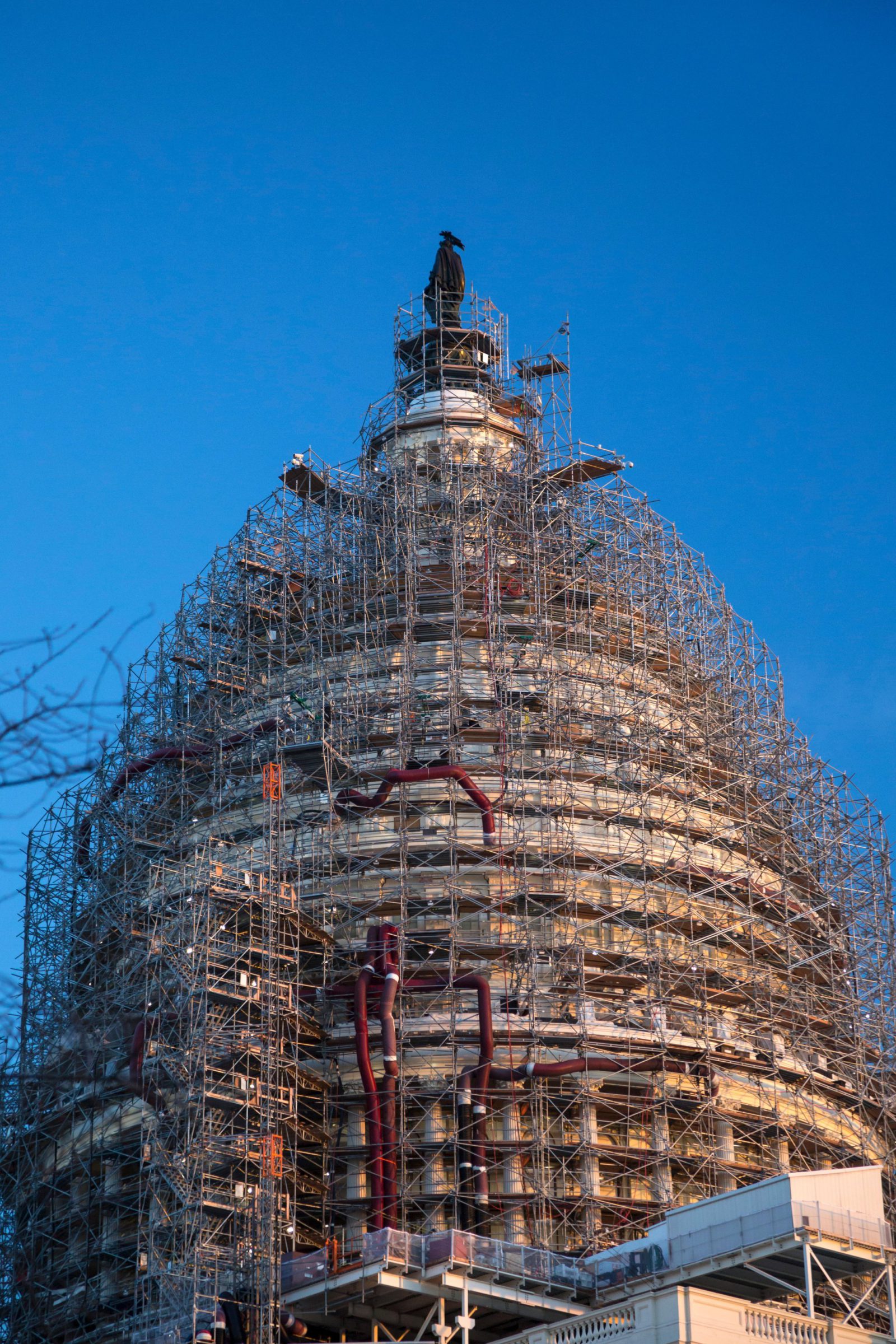

Editor’s Note: Through one of those strange mix-ups of cyberspace, The New Atlantis has obtained an email dated March 4, 2039. Written by an unknown author and brought to our attention by Philip Wallach, it appears to be a reflection on recent changes to the United States Congress, written for the occasion of the legislature’s 250th birthday.
Not so long ago, Congress was a place where good ideas went to die, consumed as it was by the worst kind of partisan squabbling. Its sorry state threatened the very viability of American government, and plenty of doom-and-gloom types pronounced the institution dead.
Now, as we mark Congress’s 250th birthday, we celebrate an institution reborn: modernized for the twenty-first century, expanded to represent America’s diversity, and streamlined to actually get things done. After years of letting rabble-rousers in the House turn our whole government upside down, we have finally adopted sensible reforms that ensure the American people’s will reigns supreme in Congress. Instead of accepting the inevitability of obstruction and dysfunction, we have entered a new era in which American government is marked by unity of purpose and action. Minority factions can still have their say, but we no longer let the tail wag the dog. Let us review how this happy transition has unfolded.
The first major shift began during the coronavirus pandemic of 2020, when the House of Representatives began to allow proxy voting and virtual hearings to limit members’ exposure to the disease. Originally intended to be temporary, these measures opened people’s eyes to the advantages of twenty-first-century communications technology, and before long the House adopted fully remote deliberation and voting. Once they could make speeches by video (and later hologram) and vote remotely, representatives were able to spend more time among their constituents and less time being socialized into the dubious ways of Washington. “Floor” votes were no longer a confusing ordeal once it became possible for representatives to precommit to voting with their party’s leadership. Legislator “independence” has now become a thing of the past, but our experience of more responsible parties has shown that it was always overrated.
A protracted government shutdown in 2024 led to another salutary change: the adoption of the Stop STUPIDITY Act, a version of which was first proposed by Mark Warner (D-VA) in 2019. Whereas lapses in federal funding previously disrupted government operations, this law ensures that appropriations remain level if the legislature fails to act. No more would there be shameful attempts to force policy changes with threats of paralyzing the whole government. Quite rightly, students of contemporary American government now regard the shutdowns of the 1980s through the early 2020s as a bizarre historical curiosity and marvel that we were willing to tolerate such a haphazard approach to funding the federal government.
Next came a more dramatic change for Congress. With voting and deliberation enhanced by new technologies, leaders of the House saw that expanding the number of representatives would present no insuperable logistical difficulties. In 2029, riding high on their second consecutive wave election, the Democratic majority updated the Permanent Apportionment Act of 1929, which had locked in the number of representatives at 435 for a century, to set the number of representatives at 1,776. That gave each House member a district of about 200,000 people, making it much more common for members to represent coherent communities. (It also has the happy side effect of making the Electoral College much less distortionary. California now has around 225 electoral votes to Wyoming’s 5 — still skewed in favor of the smaller state, but only slightly. From now on, only in the case of a historically close race could there be a divergence between the popular vote and the electoral count winner.) The demographic diversity of this enormous body has finally come to reflect the nation it represents.
The tradition-bound Senate was slow to follow the House’s example on remote voting, but it finally came around in the early 2030s. Senators are rarely seen mingled with stuffed shirts in Washington any longer. Gone are the tedious quorum calls that once took up much of the institution’s time. It turns out that the fiction that senators are speaking and listening to each other is just as easily sustained through the virtual rendering of the Senate chamber as through the selective placement of C-SPAN cameras.
Most important of all for the health of our democracy, the Senate left behind its obstructionist past and did away with the filibuster. It was only fair that a commanding majority of 58 senators, whose constituencies made up 70 percent of the American population, worked its will.

The American people themselves imposed the next, more dramatic change. Responding to the unexpected shock of China’s Great Disengagement, the president put together a wildly popular plan for reorienting America’s economy back toward manufacturing, assigning all underemployed Americans to jobs. But the Senate majority leader stubbornly refused to bring the Made in America Recovery Act to the floor, claiming it would jeopardize Americans’ economic liberties — quite an abstract concern to prioritize amid stagflation twice as severe as that of the 1970s. Americans rebelled, and the Unleash Democratic Productivity (UDP) grassroots movement took off around the country, energizing the public and scrambling the country’s political parties. To overcome the Senate’s obstruction, the group pushed a constitutional amendment reforming America’s political processes, and the necessary two-thirds vote in Congress was secured thanks to an unprecedented pressure campaign. (The roughly 80 House members and 20 senators who decided to defy UDP soon learned the extent of the group’s bottom-up democratic power — not one was reelected.) More than 40 state-ratifying conventions approved the transformative 29th Amendment within a year.
For those in need of a brief refresher, the 29th Amendment only modestly changes the Constitution, but in doing so it rebalances American government so that it finally works for the American people by empowering the president to govern. It operates through two simple mechanisms. The first: All presidential nominees must still be submitted for the advice and consent of the Senate, but now they are automatically confirmed if the Senate does not act on their nomination within 30 days (60 at the beginning of a new Congress). The second: The president can now introduce one bill to the House of Representatives on the first business day of each month (excepting election months and lame duck sessions), and the House must give that bill an up or down vote on the second Tuesday of the month, with the Senate following on the third Tuesday.
These monthly bills have sensibly become the main mechanism of American policymaking. Naturally, the president’s first bill was the Made in America Recovery Act, which set the nation on a path to full employment and strategic self-reliance. But presidential bills have become essential to the regular work of government too. Decisions on spending and debt get made decisively, without interminable delays or the ridiculous hostage-taking maneuvers of earlier times. Our various regulatory regimes get updated frequently and legislation now encompasses much of what the cumbersome system of the past forced into sub-statutory executive actions. In leading the economic reorganization mandated by the Made in America Recovery Act, the president has also speedily built up the more professional and independent civil service needed to make this effort successful. The newly created Improvement Through Machine Learning Agency has been a particular success in making job allocation orders more efficient and satisfactory — this elite unit is now, fittingly, the most desirable employer for ambitious young people.
When crises arise, presidential legislation quickly empowers our executive branch officials, and they bring their world-class credentials to bear on difficult issues that baffle legislators. Laws standing in the way of successful adaptation get changed in a hurry, notwithstanding the protests that come from self-interested defenders of the outmoded past.
There are those who whine that, with most nominees coming to their posts without votes, and Congress having rejected a presidential law no more than once (only to pass a nearly identical law the next month), our legislature has become a “mere rubber stamp.” Nonsense. Our newly expanded cadre of representatives provides better service for their constituents than their predecessors ever did. With the help of artificial intelligence–enhanced screening, people who have trouble navigating any government program get the help they need from their district office in a matter of hours. Through their innovative public discussion forums, representatives’ lively debates are more accessible to the public than ever before. Besides, in truth, legislators haven’t mostly been the ones writing legislation since the nineteenth century. The people’s will is still embodied in Congress’s votes — indeed, far more faithfully than it was in earlier decades. The enlarged House has already become a wonderful incubator of talent for those who go on to fill important executive branch positions.
With so much going right, it seems almost unnecessary to mention the persistent misbehavior of a malcontented minority, whose irrational devotion to outdated ideas make them hate our country’s progress. They have their chances to persuade their fellow citizens of the merits of their positions, in the public square and in Congress. But far too often critics of our reformed system instead resort to misinformation and dirty tricks meant to embarrass honest public servants.
Thankfully, our responsible media platforms have developed advanced techniques for containing such misbehavior. When human content moderators proved insufficient to quell the tide of disinformation, instant-fact-checking technology has helped clamp down on such ridiculous and verifiably false claims as “everything is more expensive today than it used to be” or “life was better before we gave so much power to computers” or “America didn’t always take political prisoners.” Our domestic terrorism investigators, too, have more legal power to ensure that political discourse remains within acceptable bounds. They infiltrate potentially violent groups before they ever have a chance to carry out traitorous plots or disrupt reasonable political discourse.
Dissent is, and will always be, an undying part of America’s political culture — and intraparty debate today is thriving, informing the president’s choices of what laws to propose. But honoring that tradition doesn’t mean that people trying to drag us back to the hateful ways of the twentieth century should be allowed to distort our whole democratic system. Their rallying call may be “Free politics for a self-governing people,” and that sounds very fine indeed, but in reality, what they want is a return to a broken legislature that protects the interests of undeserving incumbents and makes efficient government impossible. They have no right to impose that on the rest of us, and we are better off having adopted a system that lets us move forward in spite of their revanchism.
There are some old-timers on Capitol Hill who will tell you that Congress ain’t what it used to be — but so what? Nostalgia for simpler times doesn’t create jobs for everyone. Our current system does, and Congress plays an important part in making its programs work for everyone. That is something to celebrate as the institution turns 250.
Exhausted by science and tech debates that go nowhere?